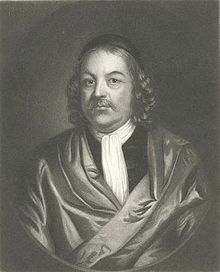
Back سيمون برادستريت Arabic Simon Bradstreet German Simon Bradstreet French サイモン・ブラッドストリート Japanese 사이먼 브래드스트리트 Korean Брэдстрит, Саймон Russian
Simon Bradstreet | |
|---|---|
 Engraving based on a painting in the Massachusetts State House | |
| 20th and 21st Governor of the Massachusetts Bay Colony | |
| In office 1679–1686 | |
| Preceded by | John Leverett |
| Succeeded by | Joseph Dudley (as President of the Dominion of New England) |
| In office May 24, 1689 – May 16, 1692 | |
| Preceded by | Sir Edmund Andros (as Governor of the Dominion of New England) |
| Succeeded by | Sir William Phips (as Governor of the Province of Massachusetts Bay) |
| Deputy Governor of Massachusetts Bay | |
| In office 1678–1679 | |
| Governor | John Leverett |
| Preceded by | Simon Symonds |
| Succeeded by | Thomas Danforth |
| Secretary of Massachusetts Bay | |
| In office 1630–1636 | |
| Preceded by | None, position established |
| Succeeded by | Increase Nowell |
| Member of the Council of Assistants | |
| In office 1630–1678 | |
| Governor | List
|
| In office 1679–1686 | |
| Governor | Himself |
| In office 1689–1692 | |
| Governor | Himself |
| Commissioner for Massachusetts Bay | |
| In office 1644–1644 | |
| In office 1648–1661 | |
| In office 1663–1664 | |
| In office 1669–1672 | |
| In office 1674–1675 | |
| In office 1677–1677 | |
| Personal details | |
| Born | baptized March 18, 1603 Horbling, Lincolnshire |
| Died | March 27, 1697 (aged 93) Salem, Province of Massachusetts Bay |
| Spouse | |
| Children | 8: Samuel, Dorothy, Sarah, Simon, Hannah, Mercy, Dudley, John. |
| Signature | |
Simon Bradstreet (baptized March 18, 1603/4[1] – March 27, 1697) was a New England merchant, politician and colonial administrator who served as the last governor of the Massachusetts Bay Colony. Arriving in Massachusetts on the Winthrop Fleet in 1630, Bradstreet was almost constantly involved in the politics of the colony but became its governor only in 1679.
He served on diplomatic missions and as agent to the crown in London, and also served as a commissioner to the New England Confederation. He was politically moderate, arguing minority positions in favor of freedom of speech and for accommodation of the demands of King Charles II following his restoration to the throne.
Bradstreet was married to Anne, the daughter of Massachusetts co-founder Thomas Dudley and New England's first published poet. He was a businessman, investing in land and shipping interests. Due to his advanced age (he died at 93) Cotton Mather referred to him as the "Nestor of New England".[2]
- ^ In the Julian calendar, then in use in England, the year began on March 25. To avoid confusion with dates in the Gregorian calendar, then in use in other parts of Europe, dates between January and March were often written with both years. Dates in this article are in the Julian calendar unless otherwise noted.
- ^ Cite error: The named reference
Mather140was invoked but never defined (see the help page).